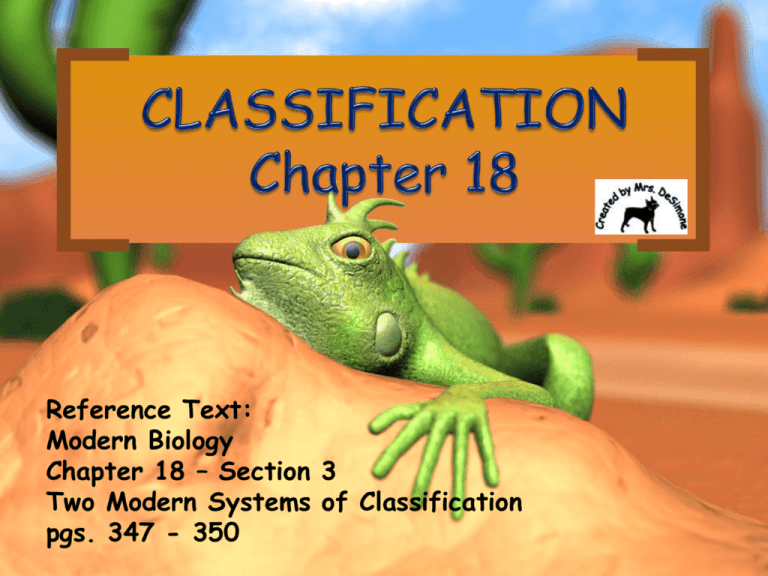unit 2 section 18
advertisement

Reference Text: Modern Biology Chapter 18 – Section 3 Two Modern Systems of Classification pgs. 347 - 350 • The Six Kingdom System and The Domain System are two alternate schemes for classifying life. Aristotle classified organisms as either plants or animals.. Linnaeus took it a step further and classified organisms into more specific groups such as class, order, family, genus and species. http://science.discovery.com/videos/100-greatest-discoveriesshorts-classification-of-species.html …some organisms don't quite fit into the plant or animal kingdom. As a result, several other kingdoms of organisms are now used. Today's scientists look at cell structure, how the organism moves, gets food, and reproduces to place it in the correct kingdom. Two Current Classification Systems •Six Kingdom System •Three Domain System Old Five Kingdom System: Monera include all prokaryotic organisms, which are all unicellular life forms that lack a true nucleus. Protista, Fungi, Plantae,Animalia include all eukaryotic organisms, which are all life forms that do contain a true nucleus and various organelles. The NEW Six Kingdom System: Archaebacteria & Eubacteria include all prokaryotic organisms, which are all unicellular life forms that lack a true nucleus. Protista, Fungi, Plantae,Animalia include all eukaryotic organisms, which are all life forms that do contain a true nucleus and various organelles. FUNGI ANIMALIA PLANTAE PROTISTS EUBACTERIA ARCHAEBACTERIA Broadest, most inclusive taxons are the Three Domains Archaea, Bacteria, and Eukaryota 9 Six-Kingdom System Three-Domain System The main criteria of grouping here is Eukaryotic vs. Prokaryotic REMEMBER: These systems are not etched in stone! They have been revised over the years, and will continue to be revised when new evidence is discovered. copyright cmassengale Domain – Archaea Kingdom - ARCHAEBACTERIA • Probably the 1 cells to evolve • Live in HARSH environments • Found in: – Sewage Treatment Plants (Methanogens) – Thermal or Volcanic Vents (Thermophiles) – Hot Springs or Geysers that are acid – Very salty water (Dead Sea; Great Salt Lake) – Halophiles • Chemosynthesis: use inorganic compounds to st make food. copyright cmassengale 13 Kingdom - ARCHAEBACTERIA Hot Springs Acid mine drainage The Dead Sea Sulfur Springs Domain - Bacteria Kingdom - EUBACTERIA • Some may cause DISEASE • Found in ALL HABITATS except harsh ones • Important decomposers for environment • Commercially important in making cottage cheese, yogurt, buttermilk, etc. (Acidophilus). copyright cmassengale 15 Kingdom - EUBACTERIA copyright cmassengale 16 Live in the intestines of animals copyright cmassengale 17 Domain Eukarya is Divided into 4 Kingdoms: Protista (protozoans, algae…) Fungi (mushrooms, yeasts …) Plantae (multicellular plants) Animalia (multicellular animals) • • • • copyright cmassengale 18 Domain: Eukarya Kingdom: Protista •Most are unicellular •Some are multicellular •Some are autotrophic, while others are heterotrophic Aquatic • copyright cmassengale 19 Domain: Eukarya Kingdom: Protista Fungus Like – made of threadlike fibers Animal Like – move around and eat other organisms Plant Like – contain chlorophyll for photosynthesis copyright cmassengale 20 Domain: Eukarya Kingdom: Fungi • Multicellular, except yeast • Absorptive heterotrophs • (digest food outside their body & then absorb it) Cell walls made of chitin 21 Domain: Eukarya Kingdom: Plantae •Multicellular •Autotrophic (except for carnivorous plants) •Absorb sunlight to make glucose – Photosynthesis Cell walls made of cellulose • http://www.youtube.com/watch?v=ph7Ex8rQ-IA 22 Mosses Liverworts Angiosperms Gymnosperms Ferns Domain: Eukarya Kingdom: Animalia •Multicellular •Ingestive heterotrophs (consume food & digest it inside their bodies) Feed on plants or animals • 24 Domain Kingdom Cell Type Cell Type Nutrition Archaea Archaebacteria Prokaryote Unicellular Both autotroph and heterotroph Bacteria Eubacteria Prokaryote Unicellular Both Eukarya Protists Eukaryote Both Both Eukarya Fungi Eukaryote Both Heterotroph Eukarya Plantae Eukaryote Multicellular Autotrophic (mostly) Eukarya Animalia Eukaryote Multicellular Heterotroph copyright cmassengale 25 Methanogens, Thermophiles, Acidophilles Characteristics Cell Virus Growth yes No Homeostasis Yes No Metabolism Yes No Mutation Yes Yes; necessary for its survival Genetic Material Yes DNA, RNA Reproduction Yes by mitosis *Yes; but only possible when inside a host cell Structure Cytoplasm, membrane bound organelles, nucleus copyright cmassengale 29 Biologists have developed a precise method to help them classify and identify unknown organisms. The classification tool called a dichotomous key •Used to identify organisms •Characteristics given in pairs •Read both characteristics and either go to another set of characteristics OR identify the organism 1a 1b 2a 2b 3a 3b 4a 4b Tentacles present – Go to 2 Tentacles absent – Go to 3 Eight Tentacles – Octopus More than 8 tentacles – 3 Tentacles hang down – go to 4 Tentacles upright–Sea Anemone Balloon-shaped body–Jellyfish Body NOT balloon-shaped - 5 copyright cmassengale 32











